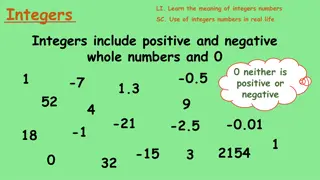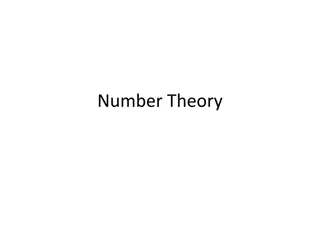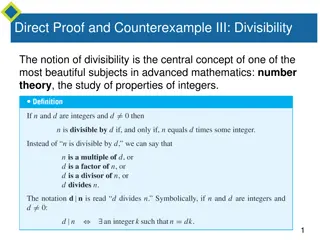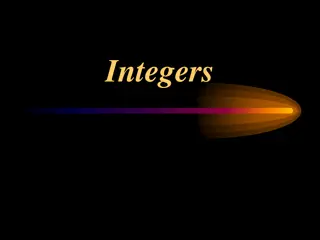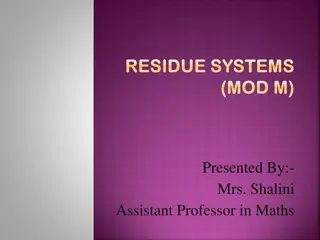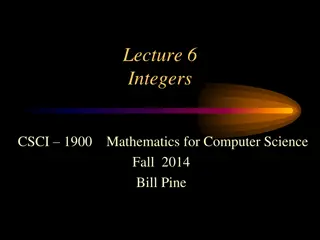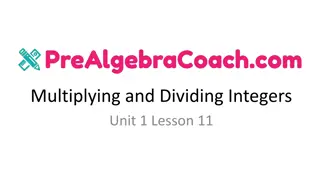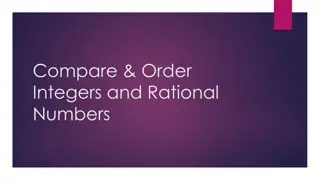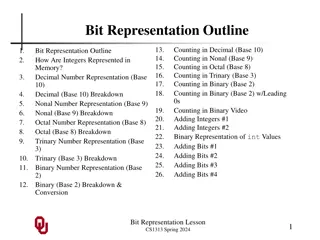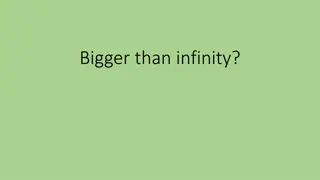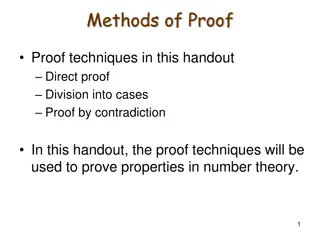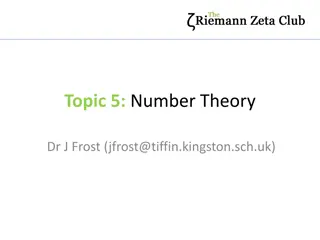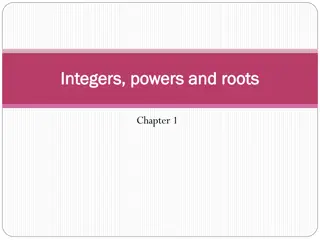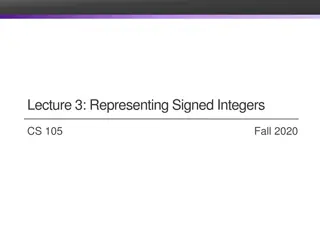Understanding Properties of Integers in Number Theory
Exploring fundamental concepts in number theory such as divisors, the divisor theorem, prime numbers, and the fundamental theorem of arithmetic. Discover the significance of integer properties in encryption algorithms and their practical applications in modern times.
Uploaded on Sep 14, 2024 | 0 Views
Download Presentation

Please find below an Image/Link to download the presentation.
The content on the website is provided AS IS for your information and personal use only. It may not be sold, licensed, or shared on other websites without obtaining consent from the author. Download presentation by click this link. If you encounter any issues during the download, it is possible that the publisher has removed the file from their server.
E N D
Presentation Transcript
Properties of Integers 4.3, 4.4, 4.5
Acknowledgements Some slides are taken from the following: Lecture slides prepared by Prof. Bulatov Lecture slides prepared by Prof. Sukumar Ghosh Lecture slides prepared by Prof. Denenberg
Preamble Historically, number theory has been a beautiful area of study in pure mathematics. However, in modern times, number theory is very important in the area of security. Encryption algorithms heavily depend on modular arithmetic, and our ability to deal with large integers. We need appropriate techniques to deal with such algorithms. Hashing technique has become quite popular whose underlying principle is modular arithmetic.
Divisors Let a, b, c are integers such that c = ab. a and b are called divisors of c a|c b|c 105 = 15 7 implies 15|105 and 7|105
Divisor Theorem Theorem: Let a, b, and c be integers. Then a|b a|c implies a|(b+c) a|b implies a|bc a|b b|c implies a|c
Divisor Theorem Theorem: Let a, b, and c be integers. Then a|b a|c implies a|(b+c) a|b implies a|bc a|b b|c implies a|c a|b implies b = a . t1, t1 is an integer a|c implies c = a . t2, t2 is an integer b + c = a (t1 + t2). Therefore, a|(b+c). b c = a (t1 t2). Therefore, a|(b-c)
Prime numbers A number n 2 is prime if and only if it is divisible by only 1 and itself. A number which is not a prime is called composite. 15 is composite 23 is prime
Fundamental Theorem of Arithmetic Theorem: Any number n 2 is expressible as a unique product one or more primes. 100 = 2 2 5 5 = 22.52 29338848000 = 28355373111
How many divisors? How many positive divisors does n have? when n= 100, the divisors are 1, 2, 4, 5, 10, 20, 25, 50, 100 n = 2252 Divisors are : 2050, 2051,2052; 2150, 2151,2152; 2250, 2251,2252
How many divisors? How many positive divisors does n have? Write n in its unique prime factorization paqb sd where p,q, ., s are prime. Any divisor of n has the form pxqy sz where 0 x a, 0 y b, ., 0 z d. The total number of divisors of n is (a+1)(b+1) (d+1). x can assume (a+1) different values, y can assume (b+1) different values, and so on. The product rule is then applied.
How many divisors? How many divisors of n are perfect squares? A number is a perfect square if and only if each of the exponents in its prime factorization is even. Any perfect square divisor of n has the form p2x q2y s2z where 0 2x a, 0 2y b, .,0 2z d. The total number of divisors of n is (floor(a/2)+1)(floor(b/2)+1) (floor(d/2)+1).
Computing div and mod 17 mod 6 23 div 5 -10 mod 5 -13 mod 6 -13 div 6
Computing div and mod 17 mod 6 (ans: 5) 23 div 5 (ans: 4) -10 mod 5 (ans: 0) -13 mod 6 (ans: 5) -13 div 6 (ans: -3) a mod b gives the remainder when a is divided by b. a div b gives the quotient when a is divided by b.
GCD Definition: Let a, b Z where a b, and b 0. Then c Z+ is called a greatest common divisor of a,b if (a) c|a and c|b (b) for any common divisor d of a and b, we have d|c. gcd(24,18) = 6
GCD Definition: Let a, b Z where a b, and b 0. Then c Z+ is called a greatest common divisor of a,b if (a) c|a and c|b (b) for any common divisor d of a and b, we have d|c. a and b are said to be relatively prime if and only if gcd(a,b) = 1. a and b do not have any common divisors. 4 and 9 are relatively prime since gcd(4,9)=1.
Finding the Greatest Common Divisor Using Prime Factorizations Example: 120 = 23 3 5 500 = 22 53 gcd(120,500) = 2min(3,2) 3min(1,0) 5min(1,3) =22 30 51 = 20
Finding the Greatest Common Divisor Using Prime Factorizations Suppose the prime factorizations of a and b are: where each exponent is a nonnegative integer, and where all primes occurring in either prime factorization are included in both. Then:
Finding the Greatest Common Divisor Using Prime Factorizations Finding the gcd of two positive integers using their prime factorizations is not efficient because there is no efficient algorithm for finding the prime factorization of a positive integer.
Least Common Multiple Definition: The least common multiple of the positive integers a and b is the smallest positive integer that is divisible by both a and b. It is denoted by lcm(a,b). lcm(6,10) = 30.
Least Common Multiple Definition: The least common multiple of the positive integers a and b is the smallest positive integer that is divisible by both a and b. It is denoted by lcm(a,b). The least common multiple can also be computed from the prime factorizations. This number is divided by both a and b and no smaller number is divided by a and b. Example: lcm(233572, 2433) = 2max(3,4) 3max(5,3) 7max(2,0) = 24 35 72
lcm and gcd lcm(233572, 2433) = 2max(3,4) 3max(5,3) 7max(2,0) = 24 35 72 gcd gcd( (233572, 2433) = 2min(3,4) 3min(5,3) 7min(2,0) = 23 33 243572 x 2333 = 27 38 72
Least Common Multiple The greatest common divisor and the least common multiple of two integers are related by: Theorem: Let a and b be positive integers. Then ab = gcd(a,b) lcm(a,b)
Euclidean Algorithm Example: Find gcd(287,91): 287 = 91 3 + 14 91 = 14 6 + 7 14 = 7 2 + 0 Divide 287 by 91 Divide 91 by 14 Divide 14 by 7 Stopping condition gcd(287, 91) = gcd(91, 14) = gcd(14, 7) = 7
Euclidean Algorithm: key property Lemma: Let a = bq + r, where a, b, q, r are positive integers, 0 r < b, then gcd(a,b) = gcd(b,r). (Assuming a b.) Why? Consider an arbitrary divisor k of a and b. k|a ; k|b k|a-b ; k|b k|a-2b ; k|b k|a-qb ; k|b k|r ; k|b. gcd(a,b) = gcd(b,r)
Euclidean Algorithm The Euclidean algorithm expressed in pseudocode is: proceduregcd(a, b: positive integers) if a < b then swap(a,b) (i.e. c=a, a=b, b=c) x := a y := b while y 0 r := xmody x := y y := r returnx {gcd(a,b) = x}
Example Find d = gcd(821,123) 821 =123 6 + 83 (1) 123 = 83 1 + 40 . (2) 83 = 40 2 + 3 . (3) 40 = 3 13 + 1 . (4)
Example d = gcd(821,123) = 1 (i.e. 821 and 123 are relatively prime) We can find integers u and v such that 1 = 821u +123v. 821 =123 6 + 83 (1) 123 = 83 1 + 40 . (2) 83 = 40 2 + 3 . (3) 40 = 3 13 + 1 . (4)
Example Find d = gcd(821,123) = 1 We can find integers u and v such that d = 821u +123v. 821 =123 6 + 83 (1) 123 = 83 1 + 40 . (2) 83 = 40 2 + 3 . (3) 40 = 3 13 + 1 . (4) Now we can write 1 = 40 3 13 (from (4)) 1 = 40 (83 - 40 2) 13 (using (3)) 1 = 40 27 83 13 1 = (123 83 1) 27 83 13 (from (2)) 1 = 123 27 83 40 1 = 123 . 27 (821 123 6) 40 (from (1)) 1 = 123 267 821 40 Thus we have u = -40 and v = 267.
Example Find d = gcd(821,123) and integers u and v such that d = 821u +123v. 821 =123 6 + 83 (1) 123 = 83 1 + 40 . (2) 83 = 40 2 + 3 . (3) 40 = 3 13 + 1 . (4) Now we can write 1 = 40 3 13 (from (4)) 1 = 40 (83 - 40 2) 13 (using (3)) 1 = 40 27 83 13 1 = (123 83 1) 27 83 13 (from (2)) 1 = 123 27 83 40 1 = 123 . 27 (821 123 6) 40 (from (1)) 1 = 123 267 821 40 Thus we have u = -40 and v = 267. The gcd of 821 and123 can be expressed as a linear combination of 821 and 123:
Example 1 Griffin has two unmarked containers. One container holds 17 litres and the other holds 55 litres. Explain how Griffin can use his two containers to measure exactly one litre.
Example 1 Griffin has two unmarked containers. One container holds 17 litres and the other holds 55 litres. Explain how Griffin can use his two containers to measure exactly one litre. gcd(55,17) = 1. 1 = 13 (17) 4 (55) Rest is easy
Example 1 Griffin has two unmarked containers. One container holds 17 litres and the other holds 55 litres. Explain how Griffin can use his two containers to measure exactly one litre. gcd(55,17) = 1. 1 = 13 (17) 4 (55) Rest is easy How about measuring 3 litres? Can it be done? Yes, since gcd(17,55) divides 3.
Example 1 Griffin has two unmarked containers. One container holds 17 litres and the other holds 55 litres. Explain how Griffin can use his two containers to measure exactly one litre. gcd(55,17) = 1. 1 = 13 (17) 4 (55) Rest is easy How about measuring 3 litres? Can it be done? Yes, since gcd(17,55) divides 3. 3 = 39 (17) 12(55)
Example 3 Brian 6 minutes on an average to help a student debug a Java code, and takes 10 minutes on an average to debug a C++ program. If he works continuously for 104 minutes, and doesn t waste any time, how many programs can he debug in each language? We seek integers x,y 0 where 6x + 10y =104. Can this be done?
Example 3 We seek integers x,y 0 where 6x + 10y =104. gcd(6,10) = 2 We can write 2 = 2 (6) 1(10) = 6 (2) + 10 (-1). Then 104 = 6(2 x 52) + 10 (-1 x 52) ------------ (A)
Example 3 We seek integers x,y 0 where 6x + 10y =104. gcd(6,10) = 2 We can write 2 = 2 (6) 1(10) = 6 (2) + 10 (-1). Then 104 = 6(2 x 52) + 10 (-1 x 52) Compute lcm(6,10) = 30. We can write (A) as 104 = 6(104 5k) + 10 (-52+ 3k) for any integer k. ----------------------(B) ------------ (A)
Example 3 We seek integers x,y 0 where 6x + 10y =104. gcd(6,10) = 2 We can write 2 = 2 (6) 1(10) = 6 (2) + 10 (-1). Then 104 = 6(2 x 52) + 10 (-1 x 52) Compute lcm(6,10) = 30. We can write (A) as 104 = 6(104 5k) + 10 (-52+ 3k) for any integer k. ----------------------(B) We note that 104 -5k 0 when k 104/5 = 20.xxxx Similarly -52+ 3k 0 when k 52/3 = 17.xxxx k = 18, 19 and 20 integer values of k will realize 104 -5k 0 and -52 + 3k 0 . ------------ (A)
Example 3 We seek integers x,y 0 where 6x + 10y =104. gcd(6,10) = 2 We can write 2 = 2 (6) 1(10) = 6 (2) + 10 (-1). Then 104 = 6(2 x 52) + 10 (-1 x 52) Compute lcm(6,10) = 30. We can write (A) as 104 = 6(104 5k) + 10 (-52+ 3k) for any integer k. ----------------------(B) We note that 104 -5k 0 when k 104/5 = 20.xxxx Similarly -52+ 3k 0 when k 52/3 = 17.xxxx k = 18, 19 and 20 integer values of k will realize 104 -5k 0 and -52 + 3k 0 . Plugging in k = 18, 19 and 20 in (B) we get 104 = 6 x 14 + 10 x 2 (k=18) 104 = 6 x 9 + 10 x 5 (k = 19) 104 = 6 x 4 + 10 x 8 (k=20) ------------ (A)




